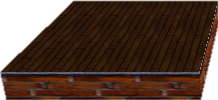Big Boo's Haunt Tilting Platform
| Big Boo's Haunt Tilting Platform | |

| |
| Technical Constants | |
| Object Group | Surface |
| Actor Group | N/A |
| Tangibility Radius | 2000 |
| Draw Distance | 4000 |
The Big Boo's Haunt Tilting Platform is an object appearing on the second floor of the house in Big Boo's Haunt. When Mario stands on it, it begins to tilt.
Behavior
The platform's behavior differs between the initial Japanese release and later releases. In the Japanese version, if Mario is interacting with the platform, the platform’s pitch velocity is set to be the distance from the object to Mario times the cosine of the angle between Mario and the platform. Then, the platform’s facing angle is increased by the pitch velocity every frame. If Mario is not interacting with the platform, the platform will begin moving toward the horizontal at 200 angular units/frame (1.1 degrees/frame). If the platform’s angle is within 200 angular units of the horizontal, its angle is set directly to 0 units.
In the US version, if Mario is interacting with the platform, its action is set to the action for when Mario is on, and if Mario is not interacting with the platform, its action is set to the action for when Mario is off. The game then checks if the platform’s action is set to the one for when Mario is on the platform. If it is, the platform’s pitch velocity is set to be the distance from the object to Mario times the cosine of the angle between Mario and the platform. Then, the platform’s facing angle is increased by the pitch velocity every frame. If the platform is not in the action for Mario being on, then, if the platform’s angle has not tilted more than 3000 angular units (16.48 degrees) or if Mario was on the platform for more than 16 frames, the platform will begin moving toward the horizontal at 200 angular units/frame (1.1 degrees/frame). If the platform’s angle is within 200 angular units of the horizontal, its angle is set directly to 0 units.
The key difference between the two versions is how quickly the platform begins to rotate back to the horizontal. In that Japanese version, this happens as soon as Mario gets off the platform no matter how far it has rotated. In the US version, if Mario gets off the platform and it has rotated more than 3000 angular units in less than 16 frames, the platform keeps rotating for another 16 frames and then moves back toward the horizontal. The other difference is in how the game handles whether Mario is on the platform or not. In the US version, the platform’s action is updated, while this is not the case in the Japanese version. This was changed for the US version so that the platform’s timer attribute is reset whenever Mario gets on or off the platform.
References
| |||||||||||||||||||||||||||||